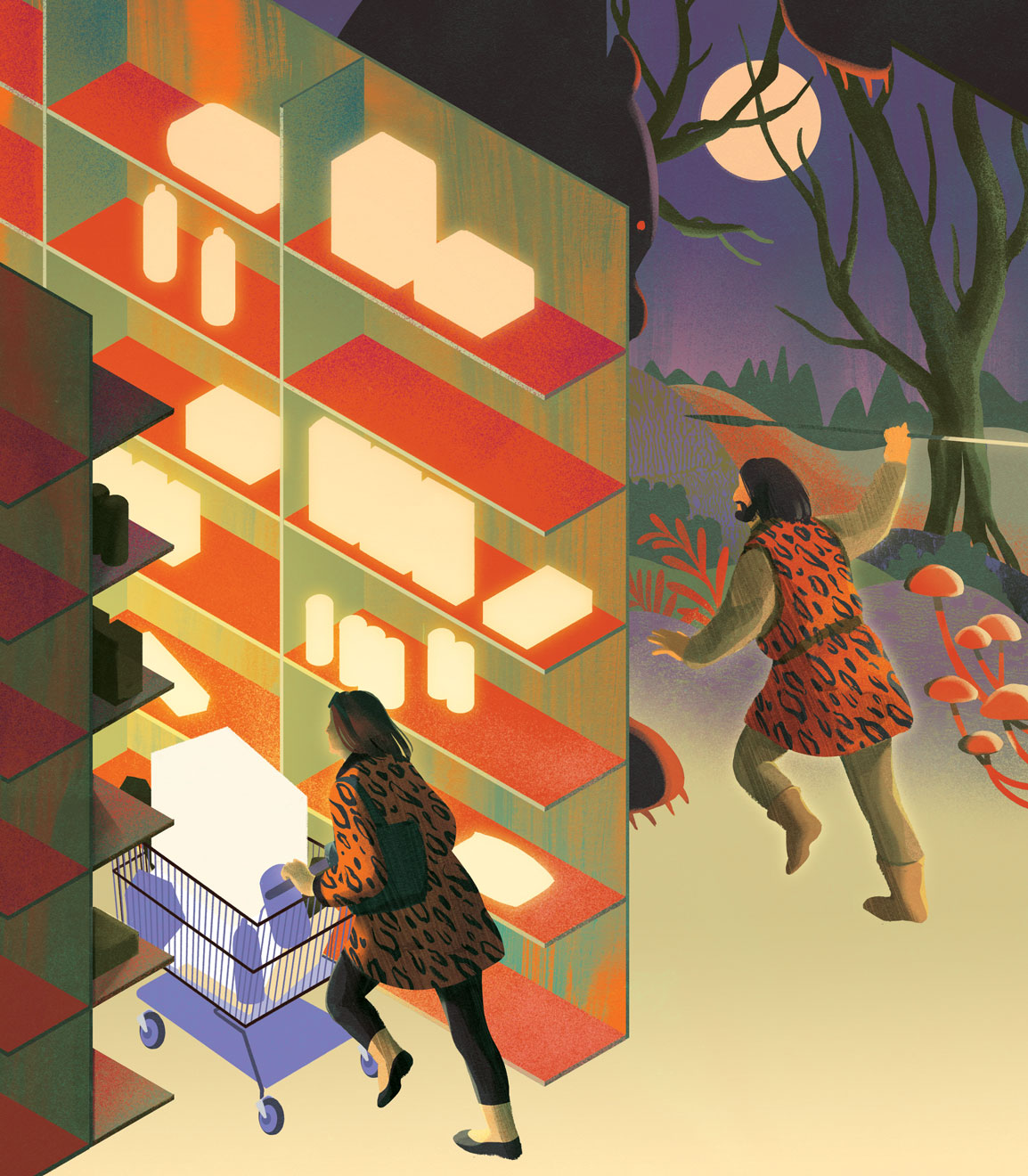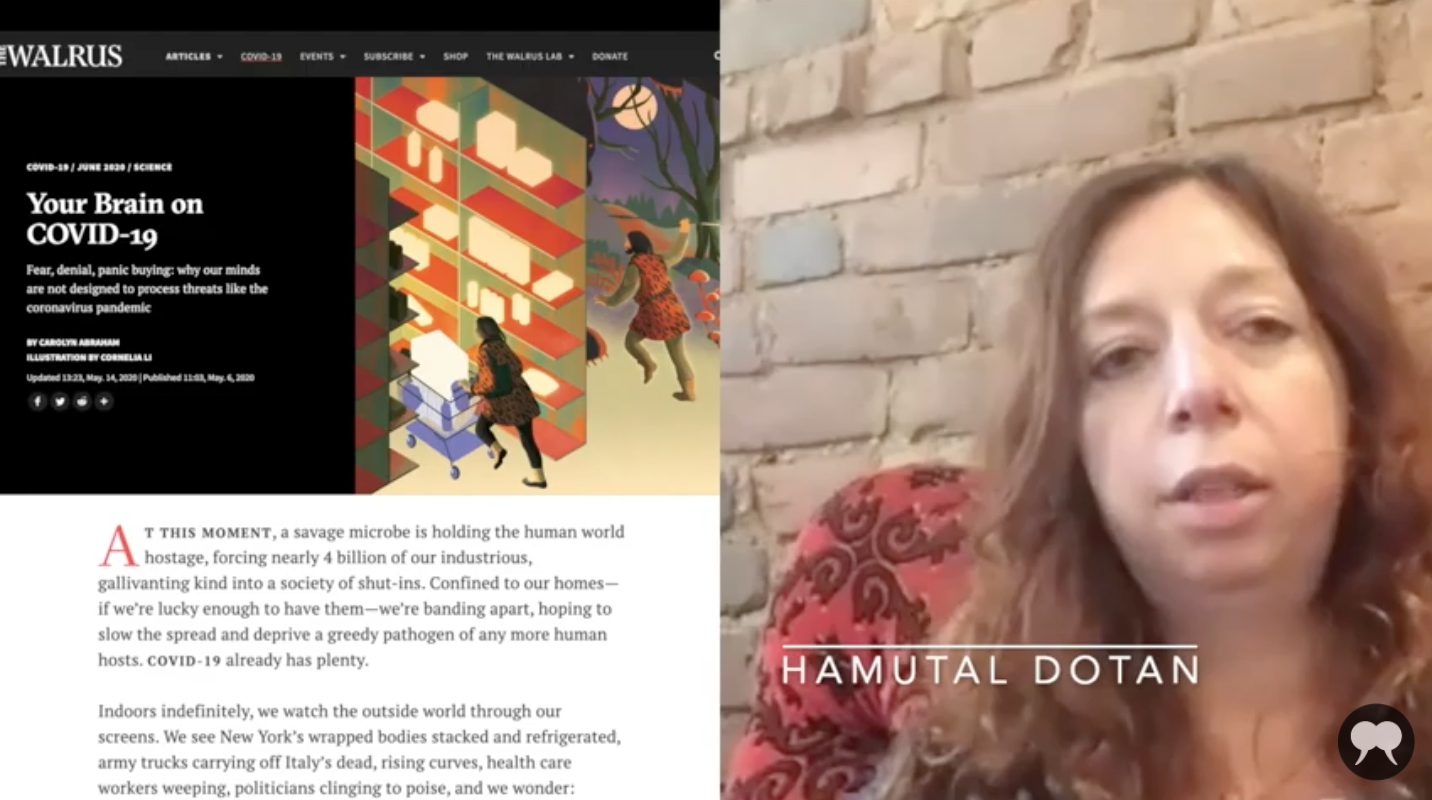At this moment, a savage microbe is holding the human world hostage, forcing nearly 4 billion of our industrious, gallivanting kind into a society of shut-ins. Confined to our homes—if we’re lucky enough to have them—we’re banding apart, hoping to slow the spread and deprive a greedy pathogen of any more human hosts. covid-19 already has plenty.
Listen to an audio version of this story
For more audio from The Walrus, subscribe to AMI-audio podcasts on iTunes.
Indoors indefinitely, we watch the outside world through our screens. We see New York’s wrapped bodies stacked and refrigerated, army trucks carrying off Italy’s dead, rising curves, health care workers weeping, politicians clinging to poise, and we wonder: Should I buy more canned goods? Is my family safe? Can I still smell stuff? Did our lockdown come too late? Will there be jobs when it’s over? When will it be over? Is it okay to walk the dog?
Humans are not well designed for this slow-burn brand of threat. We’re better equipped for one-off attacks than abstract menaces. Give us muggers, hurricanes, sabre-toothed tigers, hazards that compel us to battle or run for our lives—not the protracted uncertainty of a contagion that has killed tens of thousands and counting.
So just how is the human brain responding to all this?
“It’s screaming,” says Susan Krauss Whitbourne, a professor of psychological and brain sciences at the University of Massachusetts Amherst. “I know, it’s a very technical term,” she jokes. “But, in our brains, there’s a lot of screaming going on right now.”
The coronavirus pandemic has triggered the brain’s ancient alarm system, Whitbourne explains. It’s sounding full blast, and who knows when it will quiet?
As with everything else covid-19 has exposed—bare-bones health care systems, threadbare social safety nets, fragile economies—it has also unmasked the flaws of our neurobiology, glitches in the way we assess risk and in the fight-or-flight way we react to it. These neural kinks from another time have shaped everything from how we responded to this virus from the get-go (or, rather, how we didn’t respond) straight through to the mental burden we carry now.
The problem, in many ways, is one of architecture. The human brain is like a three-storey heritage building, constructed haphazardly by the forces of evolution over a very long time—and the old threat-detector is in the basement.
It sprouted in the primordial ooze, 500 million years ago, bequeathed by fish to our reptilian ancestors, lizard-like creatures that slithered out to make a go of life on land. To this day, the reptilian brain—home to the brain stem and cerebellum—is the master of our vital functions: breathing, sleeping, heart rate, swallowing, movement.
The lizard brain takes its cues from the second-floor addition that the early mammals punched out about 150 million years ago, giving us the unconscious magic of our limbic system: the memory bank of our hippocampus; a hypothalamus that governs emotional responses, blood pressure, and hormones; and the wee almond-shaped fear-processing amygdala that’s been key to our survival ever since our blood ran warm.
After furry mammals eventually evolved into us, up went the top floor of our cortex, the brain’s executive suite, with its spacious lobes and their astonishing power to learn, speak, plan, anticipate, deliberate—and oh, how they love to imagine.
For all the neural advancement, threat detection remained the job of the lower structures. At the mere inkling of danger, it’s the amygdala that kicks our famous fight, flight, or freeze response into motion. It sends a distress signal to the hypothalamus, which triggers the release of adrenalin and cortisol and rouses the reptilian brain a floor below to rev the body for action, pumping up heart rate, breathing, and blood flow so we can, in a flash, dodge an oncoming car or jump back from a snake attack. Research suggests the amygdala is so attuned to danger that it can make us recoil before we’re even aware that there is a snake coming toward us in the grass.
The trouble is that, in the modern world, the limbic and lizard brains can be notorious overreactors: part of our unconscious minds, they can mistake everyday stressors for life-and-death threats. And firing up the same response to deadlines and traffic jams as they once did to charging mammoths and bison hunts gone bad can take a toll on the body. Chronically higher levels of adrenalin and cortisol can be hard on the heart, the arteries, the metabolism, and the mind.
Worse, our primitive brain regions have no capacity to distinguish between threats that are real and those we imagine. It’s a failing that contributes to disorders of panic and anxiety—and also what makes covid-19 such a headache.
As our cerebral brain contemplates the threat of covid-19, as it is so inclined to do, turning over endless permutations of the devastation the virus may cause, the limbic system pokes the reptile in the basement—which never thinks twice before jacking up the body to act—as if the microbe itself were leaping from the bushes.
“With this kind of threat, you’ve got the amygdala kicking . . . the fight-or-flight syndrome, you’re kind of operating from the brain stem and below,” says Whitbourne. However, “the fear is mixed with higher-order brain structures trying to regulate the fear and come up with a kind of a plan.”
In that way, Whitbourne says, the pandemic represents a unique threat: the brain is forced to respond to an uncertain danger and, at the same time, is dramatically affected by the effort to contain it.
“Your world is no longer the same. Usually, we have a chance to adapt to big events, and even going back to the disaster of 9/11, people had one day, one hour, or a minute and everything changed,” she says. “But it didn’t have that all-encompassing, life-changing effect on your physical self.
“This is a completely new situation. It’s not like war. You’re not directly in the scene of action, it’s not like the people in the bombing raids of World War II, for example. They knew what was coming at them—and it was terrifying, to be sure—but they could see it.”
Humans have a spotty track record of relating to the invisible—think Santa, God, climate change. It’s estimated that 20 to 30 percent of our brain is devoted to processing visual information, and what we can’t see, research suggests, we tend to forget.
But that’s not the whole story with covid-19. In neuroscience, it’s generally accepted that well-defined threats trigger fear while uncertain dangers provoke anxiety—the brain’s second defensive system. In a 2016 study from University College London, for example, researchers concluded that a more visible predator in a video game resulted in faster motor reaction times, which is in line with the fear-triggered fight-or-flight response. But, when the predator was hidden, reaction times slowed as the amygdala worked harder to assess the threat.
Whitbourne suspects that the invisible nature of the pandemic sets off a fluctuating, back-and-forth brain reaction that toggles between fear, anxiety, and calm.
Knowing there’s currently no drug to cure the disease or vaccine to prevent it may be enough to set off a flight reaction—but, in the case of covid-19, to where would we flee? Lockdown has already penned us into our homes—or whatever shelter we’ve found in this storm—where we have much time to consider how we’re feeling.
… in our brains, there’s a lot of screaming going on right now.
“When we have more time to reflect, that’s when you have more interaction between the higher-order brain structures, between the rational versus the gut-wrenching fear people have—and rightly so,” says Whitbourne. “It comes in waves, because you might calm down for a while, and then something makes you afraid again.”
Which is why the next major neural challenge is sitting still.
All over the web, funny memes have spread about the relatively miniscule sacrifice people are being asked to make to beat this viral enemy. One reads, “Your grandparents were being called to war. You’re being called to the couch.”
Yet, for some, staying inactive is its own battle. Fear, after all, is the great motivator. It kept the troglodyte searching for the perfect cave. Fear of failure keeps a student up cramming all night. Fear of the coronavirus will sway the anxious to shell out more than $50 for hand sanitizer. At the same time, the physiological impact of the reptilian brain’s fear response—pumping up energy levels as it does—cues us to do and to move. It’s the essence of fight or flight.
The brain wants to act in stressful situations, says Steven Taylor, a psychology professor at the University of British Columbia and the author of The Psychology of Pandemics. With the global spread of the coronavirus, we see the threat is major, the scope is massive, the whole world is affected; we’re primed for big action—and the instructions are: wash your hands.
For some, Taylor says, that just doesn’t seem like enough. “People want to feel like they’re doing something rather than just sitting at home twiddling thumbs.”
Even he struggles to digest the surreality of it. “It occurred to me yesterday that it’s one thing to write about a pandemic, which I did, and another thing to actually live through it. It’s a little bit disorienting to look out your window and see the streets empty.”






